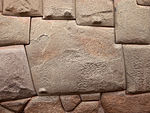
Oca is the name given to the typical Brazilian indigenous housing. The term comes from the Tupi-Guarani language family.
They are large buildings, serving as collective housing for several families, and may reach 40 m (130 ft) in length. They are built through joint effort over one week, with a wooden structure and bamboo and straw cover or palm leaves. They can last up to 15 years. They have no internal divisions or windows, only a few doors.
See also
References and notes
- General
- COP8/MOP3, 16 March 2003. Amanhã, cerimônia ao pôr do sol inaugura ocas Xavante, by Marina Koçouski.
- Arte Indígena
- Citations
- "Diferentes Moradias" (PDF). Educacional (in Portuguese). Retrieved 13 October 2016.
- "Conhecendo uma oca". Sua Pesquisa (in Portuguese). Retrieved 8 October 2016.
| Hut dwelling designs and semi-permanent human shelters | ||
|---|---|---|
| Traditional immobile |
|  |
| Traditional mobile | ||
| Open-air | ||
| Modern | ||
| Related topics | ||
| Native American architecture | ||
|---|---|---|
| Styles |  | |
| Building types | ||
| Structures | ||
| Elements | ||
This article about a Brazilian building or structure is a stub. You can help Misplaced Pages by expanding it. |